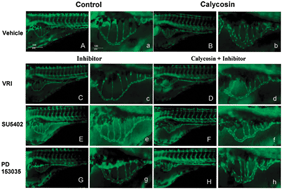Angiogenesis plays an important role in a wide range of physiological processes and many diseases are associated with the dysregulation of angiogenesis. The commonly used Chinese herbal medicine Radix Astragali (known as Huang qi in Chinese) is a potential candidate for treating this type of disease. Calycosin, a major isoflavonoid in Radix Astragali, was identified in our earlier study and shown to induce angiogenesis in human umbilical vein endothelial cells (HUVEC) in vitro and in zebrafish embryos in vivo. Using zebrafish as a testing model, we investigated the angiogenic effect of calycosin on the subintestinal vessels (SIVs) in zebrafish embryos. Our findings using transcriptional profiling by deep sequencing, and confirmed by quantitative real-time PCR (qPCR), demonstrate that calycosin modulated vascular endothelial growth factor (VEGF), fibroblast growth factor (FGF) and ErbB signaling pathways. The inhibitory effects of calycosin-induced phenotypic responses by several pathway-specific inhibitors (VRI, SU5402, MEK1/2 Inhibitor, Wortmannin and LY294002) further identified the potential involvement of VEGF(R) and FGF(R) signaling pathways in the angiogenic activities of calycosin. We present a comprehensive framework of study using fluorescence microscopy, transcriptomics and qPCR to demonstrate the proangiogenic effects of calycosinin vivo. The data have elucidated the connection between morphological observations and genomic evidence, indicating the potential roles of several key signaling pathways in angiogenesis.

You have access to this article
 Please wait while we load your content...
Something went wrong. Try again?
Please wait while we load your content...
Something went wrong. Try again?


 Please wait while we load your content...
Please wait while we load your content...